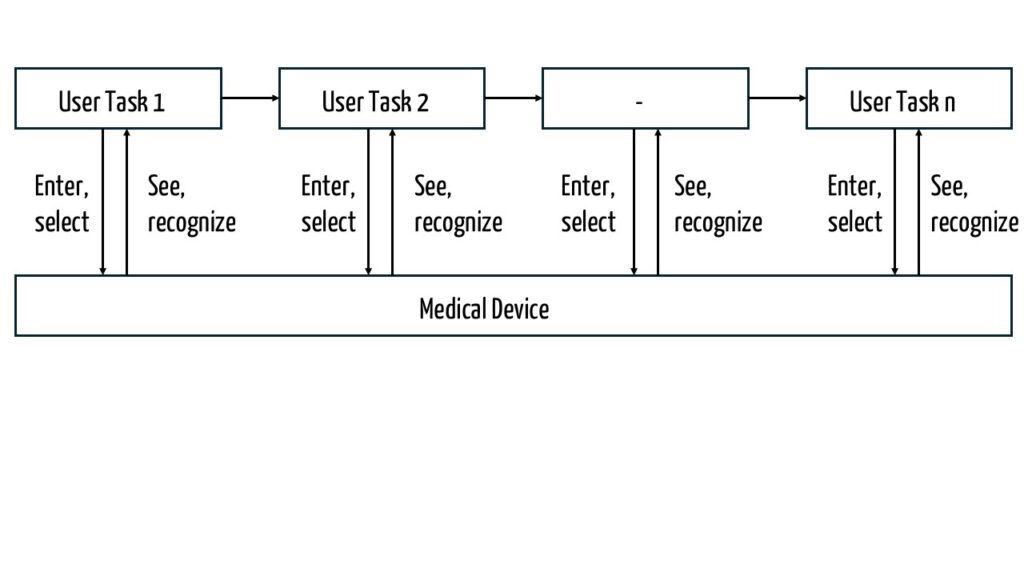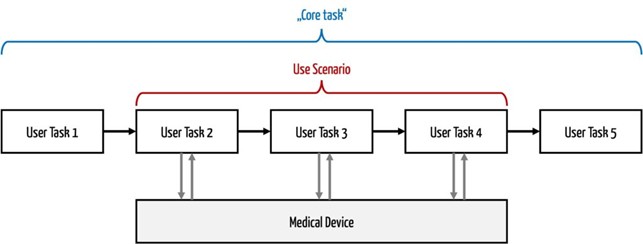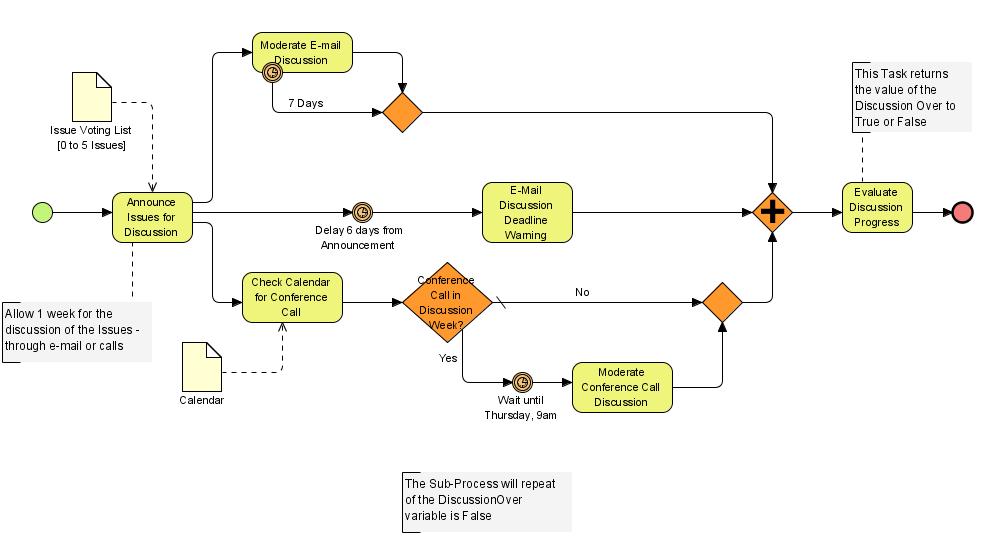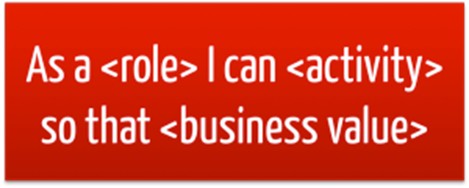IEC 62366-1 uses the concept of (hazard-related) use scenario.
The FDA recognizes critical (user) tasks. In development, use cases and user stories are used.
This variety of terms makes it difficult to achieve a common understanding. However, this is necessary to create a consistent and legally compliant usability engineering file and avoid regulatory problems. This article provides clarity.
The German version of IEC 62366-1 also refers to “Use Scenarios” and not to usage scenarios. However, it lists “usage scenario” as a synonym.
1. Why you should concern yourself with use scenarios and user tasks
a) Because it is required by law
Manufacturers must demonstrate the usability engineering of their medical devices and their safe application. This is required by the FDA as well as by laws in Europe and other markets.
Manufacturers should describe use scenarios and user tasks for both the US and EU markets. Neither use cases nor user stories are required.
Overview
| Regulations / concept to be described | FDA | MDR/IVDR | IEC 62366-1 |
| Use Scenario | Yes | No | Yes |
| Hazard-related use scenario | No | No | Yes |
| User Task | Yes | No | Yes |
| Critical Task | Yes | No | No |
| Use Case | No | No | No |
| User Story | No | No | No |
FDA requirements
In its guidance document Content of Human Factors Information in Medical Device Marketing Submissions, the FDA requires manufacturers to identify critical tasks and eliminate or at least reduce usage-related hazards. The exact requirement can also be found in the FDA’s HFE Guidance.
In the same document, the FDA also requires manufacturers to describe use scenarios:
“The submitter should also describe each use scenario included in the human factors validation testing and list the critical and non-critical tasks that constitute each use scenario.”
FDA Draft Guidance: Content of Human Factors Information
in Medical Device Marketing Submissions
Requirements of MDR and IVDR
The EU regulations MDR and IVDR only require that “risks caused by application errors” be excluded or minimized. The terms “use scenario” and “critical task” are not used in the regulations.
The article MDR requirements for usability provides a complete overview.
Requirements of IEC 62366-1
As with all general safety and performance requirements, manufacturers should benefit from harmonised standards to demonstrate conformity with these requirements.
In the case of usability engineering, EN IEC 62366-1 is the standard to be harmonized. It requires manufacturers to
- identify and describe the hazard-related use scenarios. This requires manufacturers to have identified and described the use scenarios as a whole.
- describe the tasks and their sequence,
- select the hazard-related use scenarios that are to be part of the summative evaluation (usually usability tests),
- justify this selection,
- specify the UI based on the use scenarios, and
- plan and carry out the summative evaluation for each selected hazard-related use scenario.
b) Because it enables the development of better products
Products are considered usable if they comply with the tasks of their users as effectively and efficiently as possible and to their satisfaction. This is the definition of the term “usability engineering” (according to DIN EN ISO 9241-11:2018-11).
To achieve this, it is necessary to identify the tasks and consider the order in which users should interact with the product. These are the use scenarios (as expressed in the definition).
The legal requirements for medical devices are limited to errors in use that could compromise the safety of patients, users, and third parties. User satisfaction is not required.
2. Definitions and distinctions
a) Use scenario and hazard-related use scenario
IEC 62366-1 defines the term “use scenario” as follows:
“A specific sequence of tasks performed by a specific user in a specific usage environment and any resulting response of the medical device.”
DIN EN 62366-1:2021-08, Chapter 3.22
The subset of hazard-related use scenarios is particularly relevant:
Use scenario that can lead to a hazardous situation or harm.
DIN EN 62366-1:2021-08, Chapter 3.8
The standard notes that hazard-related use scenarios are often associated with a use error. In practice, this is likely to be the case almost always.
b) (User) Tasks and Critical Task
Although IEC 62366-1 refers to tasks, it does not define the concept of “critical tasks” in the normative part. In the informative part, it states:
“A TASK in a HAZARD-RELATED USE SCENARIO where a USE ERROR can lead to significant HARM can be considered a ‘critical task’.”
In contrast, the FDA recognizes and defines the term “critical task”:
“A user task which, if performed incorrectly or not performed at all, would or could cause serious harm to the patient or user, where harm is defined to include compromised medical care”
FDA Guidance Dokumente
In the same document, it also defines the terms “task” and “serious harm”:
Task
„One or more user interactions with a medical device to achieve a desired result.“
Serious Harm
„Includes both serious injury and death.”
FDA Draft Guidance: Content of Human Factors Information
in Medical Device Marketing Submissions
When defining the term “harm,” the FDA refers to the definition in IEC 62366-1.
The definition of “serious injury” can be found elsewhere:
„An injury or illness that is life-threatening, results in permanent impairment of a body function or permanent damage to a body structure, or necessitates medical or surgical intervention to preclude permanent impairment of a body function or permanent damage to a body structure. Permanent means irreversible impairment or damage to a body structure or function, excluding trivial impairment or damage.”
FDA Draft Guidance: Content of Human Factors Information
in Medical Device Marketing Submissions
c) Distinction between use scenario and user task
A use scenario comprises a sequence of user tasks on a system (product) (see Fig. 1).

If a user task is “critical,” i.e., there is a “critical task,” the use scenario containing this task must also be assessed as “hazard-related.”.
d) Distinction between use scenario and use case
Definition „Use Case“
Unfortunately, there is no standard, binding definition of the term “use case.” The following definitions are examples:
- “A use case describes a sequence of actions a system performs that yields an observable result of value to a particular actor.” [Ivar Jacobson].
- “A use case is a sequence of actions or steps that typically define the interaction between a role (also called an actor in UML) and a system to achieve an objective.” [Source]
- “A use case specifies a sequence of actions that the system performs in interaction with the environment.” [Source]
Comparison of definitions with use scenarios
These definitions are not identical.
- According to Ivar Jacobson, it is only about the system. It is NOT about the actions of a user.
- The second definition refers to “actors.” Examples of these actors are not only users, but also other systems.
- The third definition refers to a sequence of actions. However, these are actions that the system performs with the environment, not actions that a user performs with the system.
This makes it clear that use cases (as defined by Ivar Jacobson) and usage scenarios are not directly related to each other:
| Use Scenarios | Use Cases |
| Use cases specify the sequence of user actions and system responses at the usage level in such a way that the user requirements are met. | Use cases translate usage scenarios into scenarios that specify the system’s performance. From a usability engineering perspective, this takes us to the solution level: What must the system do to ensure compliance with the user requirements? |
This is precisely what makes use cases valuable: they allow you to translate usage scenarios into system performance with minimal effort, entirely naturally! Consequently, use cases are used after user requirements and usage scenarios have been specified.
e) Distinction between use scenario and core task
A use scenario does not correspond to a core task. A core task is a task that a person must perform to achieve an objective (typically in terms of intended purpose).
A core task does not have to relate specifically to the use of a product. A core task could be, for example, “measuring your pulse,” which could also be done without a product. A use scenario, on the other hand, includes the technical solution and describes the use of a heart rate monitor from the user’s perspective.
A core task usually consists of several subtasks. Systems support some of these subtasks, sometimes even all of them. The subtasks that users perform on the system form the use scenario.

f) Distinction between use scenario and workflow
The term workflow has multiple meanings, which leads to difficulties not only in usability engineering.
Workflow and Processes
There are workflows in the sense of processes. They define the cross-role and cross-organizational collaboration between people.
These workflows can be modeled and described using Business Process Modeling Notation (BPMN), for example.

Workflow in usability engineering: usage scenarios and tasks
On the other hand, the term “workflow” is used as a synonym for “use scenario.” In this case, a workflow describes how (individual) people interact with systems within the scope of a task.
g) Distinguishing between use scenario and user stories
Objectives and wording templates
Many manufacturers use user stories to formulate requirements – usually for software – in the language of the customer or user. They benefit from “natural” formulations that correspond to everyday language, but typically fall back on sentence templates such as “As a <role> I can <activity> so that <business value>.”
An example of a user story is:
„As an EPAT (Extracorporeal Pulse Activation Technology) technician I can adjust the energy delivered in increments so as to deliver higher or lower energy pulses to the patient’s treatment area.

Comparison with use scenarios
User stories do not specify the sequence of activities. They are therefore not a substitute for use scenarios.
User stories from a regulatory perspective
There are no regulatory requirements that oblige or even suggest that manufacturers use user stories.
The Johner Institute even explicitly advises against this, as user stories often result in manufacturers not achieving regulatory compliance precisely. More on this in chapter 4 b).
3. How to document use scenarios and user tasks
a) What the regulatory documents say
Neither the FDA nor IEC 62366-1 specifies concrete requirements for how manufacturers should document use scenarios and tasks. IEC 62366-2 only states that there are many possibilities:
USE SCENARIOS can be written in many different forms, ranging from story-like narratives to simple lists of user TASKS or steps in a TASK.
IEC 62366-2:2016, Chapter 11.1
A task list is often not sufficient to meet the requirements of IEC 62366-1 to describe use scenarios. For example, the results to be achieved or post-conditions are missing, which can be used for review to verify whether the user has completed the task.
b) What the Johner Institute recommends
For this reason, we recommend describing each use scenario as follows:
Part 1: Cross-functional aspects
First, the following aspects are described:
- Intended user groups
This can be a reference to the roles specified in the intended use or “use specification.” - Intended use environment
Here, too, such a reference is recommended if the (extended) intended purpose describes this information in sufficient detail. - Preconditions
This section should describe preconditions that must be complied with by the system or the use environment, e.g.:- In the system, Authorizations have been assigned, and data have been recorded.
- In the use environment, information or additional tools are available.
- Postconditions
The type of postconditions is comparable to the kind of preconditions. An example of a postcondition is that certain information must be recorded in the system.
Part 2: Tabular description of tasks
This is the consequence of a table that specifies the tasks with their attributes line by line:
| Task, e.g., user action | Reaction of the system (via UI) | Possible usage errors | Possible reasons | Hazard situation | Possible harm with severity level | Critical task (y/n) | Measure for risk control |
| Enter new medication for selected patients | Show new medication for patient | Medication administered to wrong patient | Benefit was interrupted or there are patients with similar names | Patient takes wrong medication | High | Yes | Plausibility review (medication and diagnoses); Display of patient photo |
4. Practical tips: What you should keep in mind
a) Select the right granularity for use scenarios
Manufacturers should choose the right level of granularity when describing use scenarios:
- Excessive granularity means unnecessary effort and results in even the most minor changes changing the use scenario. This increases the effort required for “re-validation.”
- Too low a level of granularity may prevent individual critical tasks from being identified, which means that these tasks may not be selected and evaluated collectively. As a result, potential usage errors may be overlooked during identification, and an unsafe product may be released onto the market.
Therefore, the following heuristics can be helpful, especially for software UIs:
- A core task consists of seven +/- two subtasks, whereby core tasks should not be confused with use scenarios (see above).
- Individual mouse clicks do not constitute a task.
- For screen-based products, a screen often represents a subtask or a task within the use scenario.
b) Be cautious with user stories
The user stories combine the various concepts that medical device manufacturers need to describe:
| Section of the wording template | Content | Appropriate documents |
| As a <role>… | Characterization of users | Intended purpose or/and use specification |
| …I can <activity>… | Description of what the benefit must be able to do on the system | User requirement. If it has already been described how the user can do this, it is the system specification. |
| … so that <business value> | Purpose of this action | Intended purpose |
The regulations require traceability between the intended purpose, stakeholder requirements, and system requirements or system specifications. This will not be possible if everything is mixed in one sentence.
Working with user stories is no substitute for requirements engineering, especially not for the systematic derivation of usage requirements.
Therefore, avoid using user stories. They do more harm than benefit.
c) Use of professional requirements Engineering
Instead, proceed as follows:
- Formulate the intended purpose, including the medical purpose and the specified users.
- Use the context method to derive the requirements, user requirements, and core tasks.
- Use this to specify the usage scenarios and, based on these, the interactive product.
- Validate this specification.
5. Conclusion and summary
a) Variety of terms
There are a large number of terms that sound similar but must not be confused with each other:
- Use scenario and “hazard-related use scenario”
- User task and critical tasks
- Core task or core task
- Use case
- User story
Manufacturers must not confuse these terms. Otherwise, they may face regulatory difficulties.
b) A look through regulatory glasses
From a regulatory perspective, only the first two points are relevant. Even though the FDA places slightly more emphasis on the concept of tasks or “critical tasks” and IEC 62366-1 places more emphasis on the idea of “use scenarios,” it is essential in any case to identify use scenarios and their tasks in as much detail as possible and to describe potential hazards and the severity of any harm that may occur in as much detail as possible.
c) Procedure
The description of use scenarios does not replace requirements engineering, nor does it mark the beginning of requirements engineering. Instead, use scenarios to represent an intermediate step. This is because use scenarios are already part of the solution domain.
d) Importance
Precisely identified use scenarios are crucial for
- task analysis and risk analysis,
- safe medical devices,
- the summative evaluation of medical devices,
- a compliant usability engineering file and problem-free approvals,
- usable medical devices that are sought after by customers.
Manufacturers are therefore well-positioned if they systematically identify and describe use scenarios and evaluate them in usability tests.
Further information on deriving and documenting medical devices can be found in the book Usability Engineering as a Success Factor.
The Johner Institute supports medical device manufacturers in
- identifying and describing use scenarios
- select safety-related use scenarios, and
- test them in formative and summative evaluations in the institute’s usability labs (in Germany and the USA).
With this help, you can be sure of meeting the usability engineering requirements of the FDA, the EU, and other markets.
If you would like to find out more, please get in touch, e.g., via the contact form.

